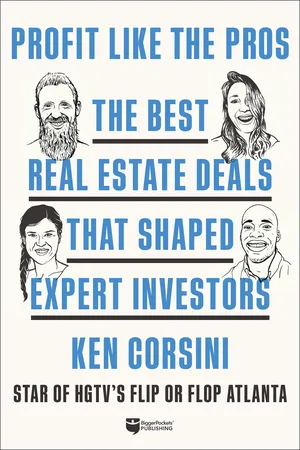![]()
CHAPTER ONE
ANSON YOUNG
Mentoring Through an Inherited Mess
When Brandon Turner introduced me to Anson Young, it didn’t take long for me to notice his unique way of thinking. Most investors tend to view value in monetary terms, but Anson is different. To him, a deal’s human dynamic is just as valuable as the money everybody walks away with. Whether by mentoring an aspiring investor, helping a family in distress, or simply ensuring his deals are more than just transactions, Anson goes beyond monetary value every step of the way.
As founder and owner of Anson Property Group LLC, in Denver, Colorado, Anson focuses on helping off-market property owners sell quickly and seamlessly. In more than ten years of investing, he has closed more than 200 wholesale deals and one hundred fix-and-flips. Throughout it all, he’s kept a healthy balance between hands-on deal management and investor outreach efforts, ensuring that he’s always giving back amid growing success.
Networking has always been a key component in Anson’s business model, whether it’s through cultivating relationships with Denver agents or connecting with members of the real estate meetup he has run for nearly ten years. He started the meetup as a way for real estate junkies to simply hang out and talk shop, but it turned out to be a deal incubator too. Anson explains:
“When I started that meetup group, I didn’t know how much real estate was about finding ways to add value for everybody. The fact is that truly caring and building rapport with people is not just enriching on a personal level—it also enables trust to be transferred to deals. It means referrals, repeat business, and more opportunities on so many levels.”
As the de facto leader of Denver’s social real estate network, Anson didn’t take long to grasp the possibilities when presented with what turned out to be his best deal ever. Not only does it combine a unique partnership with an interesting inheritance, but it also illustrates the value in building strong personal connections—something we don’t always see in real estate deals.
Over Anson’s ten years of real estate experience, he’s accumulated a healthy mix of deal types. While he has purchased, renovated, and sold more than one hundred properties, he’s also opted for a less risky approach on more than 200 deals. Wholesaling is different from a typical flip in that the investor doesn’t buy the property but instead assigns his or her purchase contract to another investor for an assignment fee. Wholesaling is a great way for a new investor to break into the business without taking on the risk and financial responsibility of actually buying a property.
Anson’s checklist for finding deals is tried and true: driving for dollars, vacant property lists, and getting in front of the gatekeepers—agents, lawyers, and estate companies—for deals. Nevertheless, the big wins nearly always come from his network. Professional connections across Denver lead to countless client referrals, but those monthly meetups have turned out to be the unexpected golden ticket. Anson says:
“I just like to connect people and connect with people, especially those who are new to the business or trying things out. The whole premise of the meetup isn’t just to snag deals, but that turns out to be one of the benefits of providing value.”
A young man named John had been attending these meetups for months, but he hadn’t yet scored a deal. For this married father of three, finding time to follow through on his dream of real estate investing wasn’t easy. Nonetheless, he felt he had enough learning under his belt that he could be confident recognizing a good deal when he saw it.
When a thorny but possibly lucrative real estate situation arose in John’s family, he found that he was first in line for an off-market deal with potential. His grandmother had recently moved into a nursing home, and the house she had lived in for forty years needed to be sold. This task fell to John’s mom and aunt, but they were already overwhelmed before things had even started.
John felt that he could help his family find a solution, but he wasn’t confident that he knew the best way to approach the situation. Of course, he could simply hand off the sale to a real estate agent and let them deal with everything, but that wouldn’t further his goal of getting hands-on investing experience.
At every meetup John attended, Anson had let attendees know that he was available to provide mentorship if they hit a sticking point with things like title issues, legal problems, or tricky negotiations. This offer hadn’t fallen on deaf ears, but John wouldn’t just be asking for advice—he had a plan. If he could get Anson on board as an investor, he could work his first flip with a trusted mentor and create a fair sale for his family.
When leaders start networking groups, it can be a phenomenal opportunity not only to mentor new and aspiring investors but also to create partnerships and facilitate more opportunities. While Anson really does run his meetup from an altruistic perspective, I know other investors who do so primarily for deal flow.
On the other hand, if you’re new to real estate and just looking to gain some experience, find a mentor. Working with a seasoned professional gives you access not only to their skill and authority but to their network (contractors, private lenders, etc.). This is especially true if you’ve already found a deal but don’t feel confident about going it alone. Find a real estate veteran to team up with, offer a lucrative partnership, and get invaluable mentorship in the process.
After John filled him in on the details, Anson agreed that the home had the makings of a great deal. Built in 1945, it was a one-story brick ranch with a basement, four bedrooms, and two bathrooms. The home had great bones, but the problem was that it hadn’t been updated since the ’70s. Even if it didn’t need any big-ticket repairs, a cosmetic overhaul would be crucial for a profitable flip.
Since it was ideally situated in a popular residential neighborhood near a well-rated elementary school, Anson knew the home’s target market would be families with young children. He also knew that these families would want more space than its current 1,200 square feet. Finishing out the basement with two additional bedrooms and a bathroom—which would add about 1,100 livable square feet—would be a huge boost to the after-repair value (ARV).
There was also the issue of stuff. This house had accumulated lots of it—furniture, clothes, and other unwanted bric-a-brac. The grandmother, it turned out, had quietly become a hoarder in her later years. In some rooms, walking from one end to the other meant navigating through four-foot piles of hoarded junk. And not only that—a whopping fourteen cats lived in and around the property. Figuring out what to do with all the stuff was the family’s most overwhelming issue.
Getting the house market-ready would probably cost around $40,000. Anson estimated the current value at around $215,000, and comparable renovated homes were selling for about $330,000. If he took on the project, he’d want at least a $50,000 profit, which meant there wouldn’t be much of a margin for error. He’d be happy to offer mentorship if the numbers worked, but first he needed to decide on an offer that was fair for everybody’s time and money.
Even though Anson had a warm introduction to the “seller”—in this case, the rest of John’s family—he still had to win them over. He and John organized a roundtable discussion to weigh options with John’s parents and two aunts. They met several times over the following weeks, but it wasn’t always about logistics. Often they didn’t discuss the property at all.
“We would talk about our silly dogs or other random things, just to get to know each other. I enjoyed this at a personal level, but at an investor level, it had the extra benefit of really helping me understand where they were coming from. All this time with the family meant that I could sincerely base my offers around what they wanted.”
Anson made no secret of the fact that they could ultimately get more money by renovating on their own and listing with an agent. However, that option would also involve managing contractors, as well as paying listing fees, commissions, appraisal and closing costs, and whatever else would arise in getting the house market-ready.
Though Anson’s offer didn’t provide the highest possible income for the family, it did provide a much higher level of simplicity. For a flat $215,000, the family could walk away from the burden of selling and simply move on. Above all, they wouldn’t have to deal with emptying out all the stuff. When Anson assured them that they could simply take what they wanted and leave the rest, their relief was palpable. Ultimately, they opted to smash the easy button and accept his offer.
Anson spent hours with this family not only building rapport but also gaining their trust. Over the course of multiple meetings, it became clear that Anson wasn’t some greedy buyer trying to take advantage of them. As an investor, it’s incredibly important to understand the needs and concerns of the seller
first. By taking this approach, you will make sellers feel heard, understood, and confident that you genuinely want to help them. From there, you can develop a game plan that isn’t solely about buying their house but about solving their specific needs.
Meanwhile, Anson and John established a partnership arrangement in which Anson would provide all the funding and project management and John would get 10 percent of the home’s resale profit. Until then, through participation, John would “earn while he learned” about scheduling, budget planning, construction walk-throughs, marketing, design, and any other aspects of the project.
Another win for networking: A private lender Anson previously worked with agreed to fund 100 percent of the purchase and renovation. He lent $255,000 at 14 percent interest on a twelve-month balloon note. With none of his own money involved and plenty of upside potential, Anson was confident that the home’s sale would cover all the accrued interest and net a profit of at least $50,000.
Anson had been in the business long enough to know that the ideal way to structure a private loan is with a balloon note. Essentially, this just means the interest accrues until either the note matures or the property is sold. For investors juggling multiple projects, structuring their private loans this way alleviates the cash-flow burden that monthly interest ...









